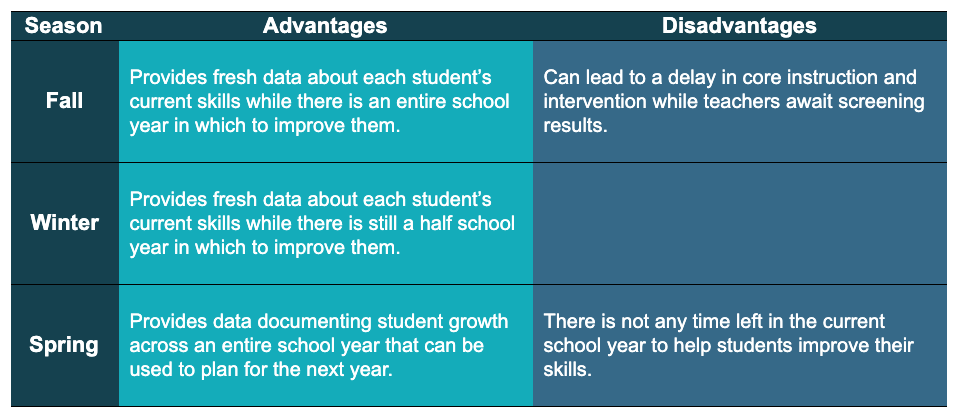Universal screening, also known as "benchmarking in schools," has become a common practice in the U.S. These screening periods provide important information for teachers at pre-determined time points during the school year.
The most common practice — at least in elementary schools — is to conduct three screenings during each school year. These are typically done in the fall, winter, and spring. At the middle and high school levels, some schools opt for one or two screenings per school year in selected grades.
A question that teachers sometimes ask is why winter screenings are necessary. In other words, "I know my students, why do I need a test them?"
While it is certainly true that teachers know their students better than when they first screened them at the start of the school year, the winter screening period is actually the most important screening period of the year, regardless of grade level. There are three main reasons for this:
- Variability in student growth
- The powerful reality of teacher expectations
- And the opportunity to make instructional changes during the second half of the school year
Variability In Student Growth Trends
Not surprisingly, most students do not make even learning gains. Growth happens in spurts throughout the school year and across grades. There are subject-specific and student-specific reasons for this. For example, in the fall of first grade, students typically make the biggest learning gains.
Why?
Because certain foundational skills are taught at this time and these skills set the stage for all later reading growth. The rate of reading improvement will gradually taper to smaller amounts in subsequent school years. It is also the case that some students will make less or more rapid gains than others. This can be due to prior learning experiences, attendance, and sometimes a disability.
Research shows that student growth rates are the most variable (and least predictable) from kindergarten through grade 3. That said, it is important to remember that all students can learn, and will learn best when teachers collect certain types of data at regular intervals to guide instruction.
Given that student growth trends are never completely consistent (and that some reliable growth patterns are known) having winter screening data is very powerful. It allows educators to know each student’s rate of improvement, as well as which students need additional instruction.
Dropped a Screening Period — Is It a Good Idea?
Growth can be determined only when there are two or more scores on the same assessment collected at different time points. When screening is conducted in the fall, winter, and spring, growth comparisons for fall-to-winter, winter-to-spring, and fall-to-spring are possible.
If one of those intervals is dropped, one comparison is still possible. If two are dropped, no within-school year comparisons are possible. There are different implications from dropping the fall, winter, or spring screenings. The following table lists the advantages and disadvantages of screening in the fall, winter, and spring.

If the fall screening is dropped (and some educators recommend this), then teachers will need to rely on other sources of information about student learning to plan and implement fall instruction. One way this can be done is to use spring screening data.
When spring screening was conducted the prior school year, for all students who attend the same district in the following fall, the prior spring’s scores can be used and teachers can begin instruction immediately instead of waiting for screening scores. I discuss the advantage of this approach in this blog post.
Jumping ahead to the end of the year, if spring screening is dropped, teachers might have other data about student performance and growth such as a state assessment or cumulative tests reflecting the entire year of learning. It would still be possible to know something about each student’s growth and whether it follows a typical pattern.
From the perspective of maximizing opportunities to use data to improve student skills, there are not any disadvantages to winter screening.
However, dropping winter screening brings the most risk to students. This is because dropping winter screening prevents teachers from having standardized growth data for all students at a moment in the school year when there is still time to provide additional instruction for students with atypical growth trends.
Even without fall or spring screening scores, winter screening provides teachers with up-to-date information about all students’ current performance that can be used to provide intervention for students with lower than expected scores.
Teacher Expectations vs. Objective Data
A second consideration for conducting winter screening is the powerful reality of teacher expectations. Many studies have confirmed that students tend to perform in the way that their teachers expect they will. In other words, student learning will fall or rise with teacher expectations. The most famous study of this was conducted in1968 by Robert Rosenthal and Lenore Jacobson and is now know as Pygmalion in the Classroom.
At the beginning of a school year, the researchers told teachers that they had given a test called the “Harvard Test of Inflected Acquisition” to elementary students. They explained to the teachers that the test results could predict which students would have strong learning gains in the coming school year and which would not. No such test was given. Instead, the researchers randomly assigned the students to test scores that supposedly reflected each student’s expected growth. The teachers were then told which students were expected to do well, and which were not.
At the end of the school year, the researchers compared the students’ learning gains over the school year and discovered alarming results. The students whose teachers expected them to do well demonstrated significantly stronger gains in both academic skills and IQ than the other students.
In other words, teacher expectations determined student learning outcomes. This is a very powerful finding. Thankfully, such a study could not be conducted today, nonetheless, teacher expectations do influence student learning.
One response to these findings is to say that all teachers just need to expect all their students to make strong gains and all will be well. However, other research indicates that teachers unintentionally develop beliefs about their students that still affect learning outcomes.
One of the best ways to prevent teacher expectations from interfering with a student’s success is to collect and use standardized and objective data several times a year. In other words, conduct universal screenings.
Universal screening data that use the same test for all of the students in a grade will provide real-time information on how much growth each student has made. When teachers examine screening data, they can compare their expectations with the results and then adjust expectations concerning the student’s actual performance.
For cases where the student performed better than the teacher expected, higher goals can be set. For students whose growth was lower than expected, teachers can then identify possible solutions.
Although teachers do “know their students,” they might have developed certain unintended expectations for student performance. But with winter screening data teachers are provided an objective look at where their students are performing compared to their goals.
The Opportunity to Course Correct Mid-Year
The final reason to conduct winter screening is also perhaps the most critical. This last major time point allows teachers the opportunity to review how all their students are progressing toward learning goals, and to then adjust instruction to optimize outcomes during the rest of the school year.
Any parent or child who recalls how a particular year of school was “lost” or “the teacher was not a good fit” knows that losing a year of learning is not just unpleasant, it also has longer-lasting outcomes.
Conclusion
Waiting until the end of a school year to see if students are on track to reach the learning goals means that we waste the precious commodity of instructional time. Conducting winter screening is an important responsibility for teachers and a gift to students because it offers the opportunity for adjustments to instruction where needed.
If you are interested in learning more about the universal screening measures available with the Formative Assessment System for Teachers (FAST), let's talk!
Reference
Rosenthal, R., & Jacobson, L. (1968). Pygmalion the classroom: Teachers expectations and pupils’ intellectual development. New York: Holt, Rinehart, & Winston.









